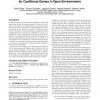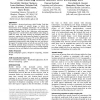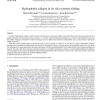40 search results - page 6 / 8 » The Core of Games on Distributive Lattices |
ATAL
2008
Springer
13 years 9 months ago
2008
Springer
Coalition formation is an important capability for automated negotiation among self-interested agents. In order for coalitions to be stable, a key question that must be answered i...
APPROX
2007
Springer
14 years 1 months ago
2007
Springer
Abstract Consider a situation where a group of agents wishes to share the costs of their joint actions, and needs to determine how to distribute the costs amongst themselves in a f...
CHI
2006
ACM
14 years 8 months ago
2006
ACM
We introduce a location?based game called Feeding Yoshi that provides an example of seamful design, in which key characteristics of its underlying technologies--the coverage and s...
CANDC
2006
ACM
13 years 7 months ago
2006
ACM
A model of hydrophobic collapse, which is treated as the driving force for protein folding, is presented. This model is the superposition of three models commonly used in protein ...
ATAL
2009
Springer
14 years 2 months ago
2009
Springer
This paper presents a framework for describing the spatial distribution and the global frequency of agents who play the spatial prisoner’s dilemma with coalition formation. The ...



